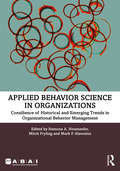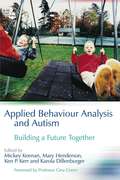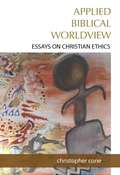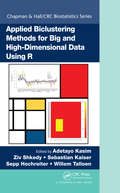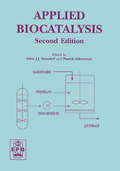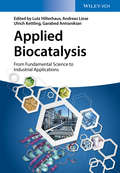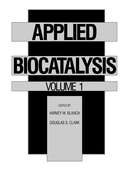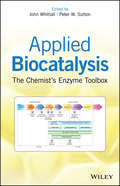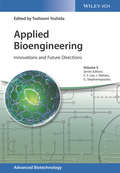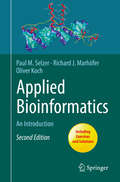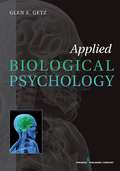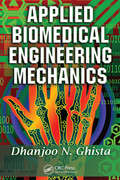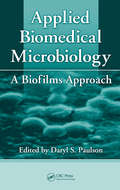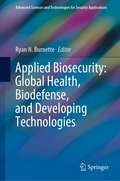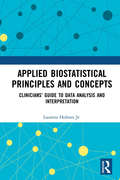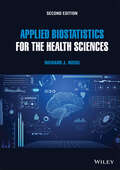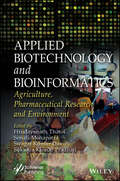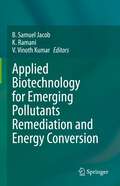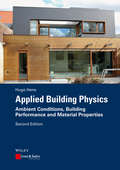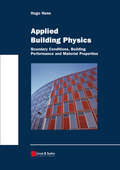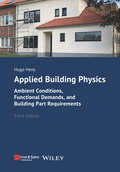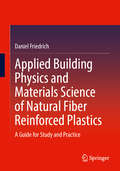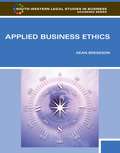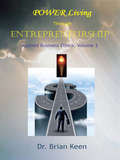- Table View
- List View
Applied Behavior Science in Organizations: Consilience of Historical and Emerging Trends in Organizational Behavior Management (Behavior Science)
by Ramona A. Houmanfar Mitch Fryling Mark P. AlavosiusApplied Behavior Science in Organizations provides a compelling overview of the history of Organizational Behavior Management (OBM) and the opportunity it presents for designing and managing positive work environments that can in turn have a positive impact on society. The book brings together leading experts from industry and research settings to provide an overview of the historical approaches in Organizational Behavior Management. It begins with an introduction to recognized practices in OBM and the applications of fundamental principles of behavior analysis to a variety of performance problems in organizational settings. The book then highlights how organizational practices and consumers’ behavior combine in a complex confluence to meet an organization’s goals and satisfy consumer appetites, whilst often unintentionally affecting the wellbeing of organizational members. It argues that the science of behavior has a responsibility to contribute to the safety, health and wellbeing of organizational members, consumers of organizational products, and beyond. Finally, the book recognizes the essential role of organizations in initiating, shaping, and sustaining the development of more nurturing and reinforcing work environments, through discussion of the need for innovation while adapting and responding to growing social upheaval, technological advances, and environmental concerns, alongside crises in the global economy, health, education, and environment. Showcasing emerging work by internationally recognized scholars on the application of behavior science in organizations, the book will be an essential read for all students and professionals of Organizational Behavior Management, as well as those interested in using organizational applications to create new models of management.
Applied Behaviour Analysis and Autism: Building A Future Together
by Ken P. Kerr Mary Henderson Karola Dillenburger Mickey KeenanApplied Behaviour Analysis (ABA) is an effective behavioural treatment programme widely used with children with autism to improve socially significant behaviours. This practical book gives detailed guidance on how to develop a tailored ABA programme that includes the key features of ABA: detailed individual behaviour assessment, reinforcement strategies to encourage new behaviours and systematic programme implementation. Chapters also include individual family case studies and discuss relevant issues such as day-to-day management of programmes for both younger and older children, collaboration in the community, sibling support, school-based programmes and obtaining services. The international contributors offer practical advice on the approach needed for the successful implementation of ABA. Applied Behaviour Analysis and Autism will be a key resource for parents, teachers, social workers, psychologists, researchers, nurses, health visitors and anyone with an interest in improving the ability to cope with the world of children with autism.
Applied Biblical Worldview: Essays On Christian Ethics
by Christopher ConeSo What Applied Biblical Worldview: Essays on Christian Ethics answers this philosophically significant question by examining worldview foundations and ethics implications for Christians and non-Christians alike. Building with a Biblical framework, several key areas are considered including: individual conduct, life and death, gender, sexuality, marriage, parental relationships, church function, economics, government, social justice, environment, pluralism, and the future.
Applied Biclustering Methods for Big and High-Dimensional Data Using R (Chapman & Hall/CRC Biostatistics Series)
by Adetayo Kasim Ziv Shkedy Sebastian Kaiser Sepp Hochreiter Willem TalloenProven Methods for Big Data Analysis As big data has become standard in many application areas, challenges have arisen related to methodology and software development, including how to discover meaningful patterns in the vast amounts of data. Addressing these problems, Applied Biclustering Methods for Big and High-Dimensional Data Using R shows how to apply biclustering methods to find local patterns in a big data matrix.The book presents an overview of data analysis using biclustering methods from a practical point of view. Real case studies in drug discovery, genetics, marketing research, biology, toxicity, and sports illustrate the use of several biclustering methods. References to technical details of the methods are provided for readers who wish to investigate the full theoretical background. All the methods are accompanied with R examples that show how to conduct the analyses. The examples, software, and other materials are available on a supplementary website.
Applied Biocatalysis
by Adrie J.J. Straathof Patrick AdlercreutzDescribing the essential steps in the development of biocatalytic processes from concept to completion, this carefully integrated text combines the fundamentals of biocatalysis with technological experience and in-depth commercial case studies. The book starts with an introductory look at the history and present scope of biocatalysis and proceeds t
Applied Biocatalysis: From Fundamental Science to Industrial Applications
by Garabed Antranikian Lutz Hilterhaus Ulrich Kettling Andreas LieseThis reference book originates from the interdisciplinary research cooperation between academia and industry. In three distinct parts, latest results from basic research on stable enzymes are explained and brought into context with possible industrial applications. Downstream processing technology as well as biocatalytic and biotechnological production processes from global players display the enormous potential of biocatalysts. Application of "extreme" reaction conditions (i.e. unconventional, such as high temperature, pressure, and pH value) - biocatalysts are normally used within a well defined process window - leads to novel synthetic effects. Both novel enzyme systems and the synthetic routes in which they can be applied are made accessible to the reader. In addition, the complementary innovative process technology under unconventional conditions is highlighted by latest examples from biotech industry.
Applied Biocatalysis: Volume 1
by Harvey W. Blanch; Douglas S. ClarkThis volume addresses the key topics: nonaqueous enzymology in general and protein design for organic solvents in particular, and enzymatic synthesis of carbon-carbon bonds, novel oligosaccharides, and modified steroids. It is a valuable source to experienced as well as potential users of enzymes.
Applied Biocatalysis: The Chemist's Enzyme Toolbox (Wiley Custom Select Ser.)
by John WhittallProvides clear and comprehensive coverage of recently developed applied biocatalysis for synthetic organic chemists with an emphasis to promote green chemistry in pharmaceutical and process chemistry This book aims to make biocatalysis more accessible to both academic and industrial synthetic organic chemists. It focuses on current topics within the applied industrial biocatalysis field and includes short but detailed experimental methods on timely novel biocatalytic transformations using new enzymes or new methodologies using known enzymes. The book also features reactions that are “expanding and making the enzyme toolbox available to chemists”—providing readers with comprehensive methodology and detailed key sourcing information of a wide range of enzymes. Chapters in Applied Biocatalysis: The Chemist’s Enzyme Toolkit are organized by reaction type and feature a short introductory section describing the current state of the art for each example. Much of the book focuses on processes for which the enzymes are readily available so that organic chemists can synthesize appropriate quantities of chemicals with available materials in a standard chemical laboratory. Advanced methods are included to present examples of new enzymes that might encourage collaboration with suppliers or academic groups and that will educate chemists of rapidly expanding future possibilities. Focuses on current topics within the applied industrial biocatalysis field Offers experimental methods on novel biocatalytic transformations using new enzymes or new methodology using known enzymes Covers the hot topics of enzyme and chemoenzymatic cascades and biocatalysis in flow Edited by noted experts from both academia and industry with years of experience in the field of biocatalysis—particularly, the industrial applications of enzymes Written for synthetic organic chemists working in all industries but especially the pharmaceutical industry and for those in academia with an eye for biocatalysis, Applied Biocatalysis: The Chemist’s Enzyme Toolkit will also benefit academic groups in chemistry and related sciences that are using enzymes for synthetic purposes, as well as those working in the area of enzymology and molecular biology.
Applied Bioengineering: Innovations and Future Directions
by Gregory Stephanopoulos Jens Nielsen Sang Yup Lee Toshiomi YoshidaA comprehensive overview of the topic, highlighting recent developments, ongoing research trends and future directions. Experts from Europe, Asia and the US cover five core areas of imminent importance to the food, feed, pharmaceutical and water treatment industries in terms of sustainable and innovative processing and production. In the field of enzyme engineering, they summarize historic developments and provide an overview of molecular enzyme engineering, while also discussing key principles of microbial process engineering, including chapters on process development and control. Further sections deal with animal and plant cell culture engineering. The final section of the book deals with environmental topics and highlights the application of bioengineering principles in waste treatment and the recovery of valuable resources. With its cutting-edge visions, extensive discussions and unique perspectives, this is a ready reference for biotechnologists, bioengineers, bioengineers, biotechnological institutes, and environmental chemists.
Applied Bioinformatics (2nd Edition): An Introduction
by Paul M. Selzer Oliver Koch Richard J. MarhöferThis book introduces readers to the basic principles of bioinformatics and the practical application and utilization of computational tools, without assuming any prior background in programming or informatics. <P><P>It provides a coherent overview of the complex field and focuses on the implementation of online tools, genome databases and software that can benefit scientists and students in the life sciences. Training tutorials with practical bioinformatics exercises and solutions facilitate the understanding and application of such tools and interpretation of results. In addition, a glossary explains terminology that is widely used in the field. This straightforward introduction to applied bioinformatics offers an essential resource for students, as well as scientists seeking to understand the basis of sequencing analysis, functional genomics and protein structure predictions.
Applied Biological Psychology
by Glen E. GetzWritten for graduate students and trainees in mental health, this is the only text to present neurobiology in the context of clinical issues rather than merely focusing on experimental approaches to biological psychology or structuring it along neurological systems. In clear, easily accessible language the text explains how the brain and nervous system are linked to mental disorders. It integrates information from many aspects of neurobiological research, including imaging, neuropsychology, and genetics in order to foster an in-depth understanding of the psychiatric presentation of disorders that mental health professionals encounter in their practices. To facilitate student learning and clarify the connection between neurobiological foundations and clinical presentation, the text includes case studies, cognitive data, imaging results, genetic testing results, and illustrations. It examines major psychological disorders from behavioral, emotional, biological, cognitive and neurophysiological perspectives as they relate to brain structure and the major systems. Special topic sections highlight ethical, research, and treatment concerns for mental health practitioners. Each chapter concludes with summations and review questions. Written for graduate level students in clinical, counseling, and school psychology programs, the text fulfills APA accreditation requirements for coursework in the biological bases of behavior. While the text's primary aim is to help students understand neurobiological information as an important component of a therapeutic framework, it also concisely addresses micro and macro anatomy as relates to neurobiology.
Applied Biomedical Engineering Mechanics
by Dhanjoo GhistaPresenting the latest innovations, this text highlights advances in tissue, musculoskeletal, locomotive, orthopedic, occupational, ergonomic, sports, cardiovascular, cardiac, and pulmonary biomechanics. Based on years of teaching experience, the author uses illustrative examples and detailed explanations to show how mechanics disciplines can be applied to a wide range of clinical applications, including the analysis of physiological and organ-system processes; the creation of physiologically compatible organ-assist systems and devices; the performance of pre-surgical analysis in order to develop optimal surgical approaches; and the design of vehicle-occupant systems for occupant comfort.
Applied Biomedical Microbiology: A Biofilms Approach
by Daryl S. PaulsonFrom the slippery covering on rocks in a stream, to the clogging slime in a bathtub drain, biofilms are present in everyday life in a variety of forms. This seemingly harmless build-up also accounts for 80 percent of all microbial infections. With chapters authored by experienced contributors from academia and industry, Applied Biomedical Microbiol
Applied Biophysics for Drug Discovery
by Donald Huddler Edward E. ZartlerApplied Biophysics for Drug Discovery is a guide to new techniques and approaches to identifying and characterizing small molecules in early drug discovery. Biophysical methods are reasserting their utility in drug discovery and through a combination of the rise of fragment-based drug discovery and an increased focus on more nuanced characterisation of small molecule binding, these methods are playing an increasing role in discovery campaigns. This text emphasizes practical considerations for selecting and deploying core biophysical method, including but not limited to ITC, SPR, and both ligand-detected and protein-detected NMR. Topics covered include: • Design considerations in biophysical-based lead screening • Thermodynamic characterization of protein-compound interactions • Characterizing targets and screening reagents with HDX-MS • Microscale thermophoresis methods (MST) • Screening with Weak Affinity Chromatography • Methods to assess compound residence time • 1D-NMR methods for hit identification • Protein-based NMR methods for SAR development • Industry case studies integrating multiple biophysical methods This text is ideal for academic investigators and industry scientists planning hit characterization campaigns or designing and optimizing screening strategies.
Applied Biosecurity: Global Health, Biodefense, and Developing Technologies (Advanced Sciences and Technologies for Security Applications)
by Ryan N. BurnetteThis book describes an adaptable biothreat assessment process to complement overall biorisk management programs, incorporating threat management and the unique natures of biological assets. Further, this book examines the nexus between public health, international security, and developing technologies, building a case for augmenting biosecurity to levels beyond the laboratory constraints. With the face of biological and biomedical sciences changing, this book describes how with proper biosecurity development, these can become assets, rather than liabilities, to secure our world from natural and man-made biological disasters. The world is changing rapidly with respect to developing threats, such as terrorism, and dual-use technologies, such as synthetic biology, that are challenging how we think about biosafety and biosecurity. Further, the fields of public health and international security are colliding, as both of these share the common enemy: intentional or natural biological incidents. To date, biosecurity has been limited to laboratory-level application, and complicating efforts, and lacks credentialed biosecurity professionals skilled in both the biological sciences and threat management techniques. The result is a fragmented field of practice, with tremendous need, from the lab to the outbreak. Underpinning these principles is the SARS-CoV-2 coronavirus pandemic, providing a historic milestone to examine biosecurity through a global lens. This book describes biosecurity as a set of practices and principles to be augmented out of the constrained laboratory environment, and applied to larger efforts, such as international threat reduction and biological incident management.
Applied Biostatistical Principles and Concepts: Clinicians' Guide to Data Analysis and Interpretation
by Laurens Holmes, Jr.The past three decades have witnessed modern advances in statistical modeling and evidence discovery in biomedical, clinical, and population-based research. With these advances come the challenges in accurate model stipulation and application of models in scientific evidence discovery Applied Biostatistical Principles and Concepts provides practical knowledge using biological and biochemical specimen/samples in order to understand health and disease processes at cellular, clinical, and population levels. Concepts and techniques provided will help researchers design and conduct studies, then translate data from bench to clinics in attempt to improve the health of patients and populations. This book is suitable for both clinicians and health or biological sciences students. It presents the reality in statistical modelling of health research data in a concise manner that will address the issue of "big data" type I error tolerance and probability value, effect size and confidence interval for precision, effect measure modification and interaction as well as confounders, thus allowing for more valid inferences and yielding results that are more reliable, valid and accurate.
Applied Biostatistics for the Health Sciences
by Richard J. RossiAPPLIED BIOSTATISTICS FOR THE HEALTH SCIENCES APPLIED BIOSTATISTICS FOR THE HEALTH SCIENCES In this newly revised edition of Applied Biostatistics for the Health Sciences, accomplished statistician Dr. Richard Rossi delivers a robust and easy-to-understand exploration of statistics in the context of applied health science and biostatistics. The book covers sample design, logistic regression, experimental design, survival analysis, basic statistical computation, and many more topics with a strong focus on the correct use and interpretation of statistics. The author also explains how to assess the quality of observed data, how to collect quality data, and the use of confidence intervals in conjunction with hypothesis and significance tests. A thorough introduction to biostatistics, including explanations of fundamental concepts like populations, samples, statistics, biomedical studies, and data set examples A comprehensive exploration of population descriptions, including qualitative and quantitative variables, multivariate data, measures of dispersion, and probability Practical discussions of random sampling, summarizing random samples, and the measurement of the reliability of statistics In-depth examinations of confidence intervals, statistical hypothesis testing, simple and multiple linear regression, and experimental design Perfect for health science and biostatistics students and professors at the upper undergraduate and graduate levels, Applied Biostatistics for the Health Sciences is also a must-read reference for practitioners and professionals in the fields of pharmacy, biochemistry, nursing, health care informatics, and the applied health sciences.
Applied Biotechnology and Bioinformatics: Agriculture, Pharmaceutical Research and Environment
by Hrudayanath Thatoi Sonali Mohapatra Swagat Kumar Das Sukanta Kumar PradhanThis comprehensive reference book discusses the convergent and next-generation technologies for product-derived applications relevant to agriculture, pharmaceuticals, nutraceuticals, and the environment. The field of modern biotechnology is a multidisciplinary and groundbreaking area of biology that includes several cutting-edge methods due to developments in forensics and molecular modeling. Bioinformatics is a full-fledged multidisciplinary field that combines advances in computer and information technology. Numerous applications of bioinformatics—primarily in the areas of gene and protein identification, structural and functional prediction, drug development and design, folding of genes and proteins and their complexity, vaccine design, and organism identification—have contributed to the advancement of biotechnology. Biotechnology is also essential to crop improvement in agriculture because it allows genes to transfer across plants to increase traits such as disease resistance and yield. It also plays a broad role in healthcare, including genetic testing, gene therapy, pharmacogenomics, and drug development. Bioremediation and biodegradation, using microbial technologies to clean up environmental contamination, waste management technologies, and the conversion of organic waste to biofuels. Bioinformatics plays a critical role in analyzing different types of data created by high-throughput research methods—such as genomic, transcriptomic, and proteomic datasets—that are useful in addressing various problems related to disease management, clean environment, alternative energy sources, agricultural productivity, and more. Audience The book will interest biotechnology researchers and bioinformatics professionals working in the areas of applied biotechnology, bioengineering, biomedical sciences, microbiology, agriculture and environmental sciences.
Applied Biotechnology for Emerging Pollutants Remediation and Energy Conversion
by B. Samuel Jacob K. Ramani V. Vinoth KumarThis contributed volume comprises of detailed chapters covering the biotechnological approaches employed for the removal of toxic recalcitrant xenobiotics such as petroleum hydrocarbons, textile dyes, microplastics and synthetic polymers that pose serious threat to the environment. It also includes the waste to energy conversion strategies that provides a deep insight on the need for waste circular economy for different developing countries and its implication on sustainable development goals such as SDG 12 (responsible consumption and production) SDG 14 (Life below water); and SDG 15 (Life on land). Emerging pollutants sourced from both industries and anthropogenic activity have created havoc in recent years for public health and destruction of biodiversity at multiple levels. The alarming increase in the global population and rapid industrialization might aggravate the problems associated with these hazardous pollutants in near future. Effluent from different industries may contain high amounts of xenobiotic hazardous contaminants such as dyes, hydrocarbons, synthetic surfactants, microplastics, etc. Industries and public sewers handling such waste streams are facing a plethora of challenges in the effluent treatment and solid waste disposal due to various factors that start from production to adoption of appropriate technologies. Therefore, there is an immediate circumvention of bottlenecks through sustainable mitigation strategies. This book is of interest to teachers, researchers, climate change scientists, capacity builders and policymakers. Also, the book serves as additional reading material for undergraduate and graduate students of agriculture, forestry, ecology, soil science, and environmental sciences. National and international agricultural scientists, policy makers also find this to be a useful read.
Applied Building Physics: Ambient Conditions, Building Performance and Material Properties
by Hugo S. HensBad experiences with construction quality, the energy crises of 1973 and 1979,complaints about `sick buildings?, thermal, acoustical, visual and olfactory discomfort, the need for good air quality, the move towards more sustainability ? all these have accelerated the development of a field that, for a long time, was hardly more than an academic exercise: building physics. The discipline embraces domains such as heat and mass transfer, building acoustics, lighting, indoor environmental quality and energy efficiency. In some countries, fire safety is also included. Through the application of physical knowledge and its combination with information coming from other disciplines, the field helps to understand the physical phenomena governing building parts, building envelope, whole building and built environment performance, although for the last the wording `urban physics? is used. Building physics has a real impact on performance-based building design. This volume on `Applied Building Physics? discusses the heat, air and moisture performance metrics that affect building design, construction and retrofitting.
Applied Building Physics: Boundary Conditions, Building Performance and Material Properties
by Hugo S. HensThe energy crises of the 1970s, persisting moisture problems, complaints about sick buildings, thermal, visual and olfactory discomfort, and the move towards more sustainability in building construction have pushed Building Physics to the forefront of building innovation. The societal pressure to diminish energy consumption in buildings without impairing usability acted as a trigger to activate the whole notion of performance based design and construction. As with all engineering sciences, Building Physics is oriented towards application, which is why, after a first book on fundamentals this second volume examines performance rationale and performance requirements. Outdoor and indoor climate conditions are described and calculation values are discussed, the performance concept is specified at the building level and at the building envelope level, and heat-air-moisture material properties are defined. The book incorporates 35 years of teaching Building Physics to architectural, building and civil engineers, bolstered by 40 years of experience, research and consultancy.
Applied Building Physics: Ambient Conditions, Functional Demands, and Building Part Requirements
by Hugo S. HensWhile the first volume on building physics deals with the physical principles of heat, air and moisture behaviour of buildings, building structures and components, this second volume on applied building physics focuses on the question of what the desired performance of buildings consists of. To achieve this, knowledge of the external environmental effects and the internal live loads to which buildings are subjected is a necessary first step. Subsequently, the performance requirements and the physical correspondences are deepened with the determination of their physical parameters, at the levels of buildings, building structures and building components. Compared to the second edition, the discussion of criteria is not limited to thermal comfort, but also includes acoustic, visual and olfactory aspects. Likewise, the indoor air quality is considered in a broader way. Analyses and calculations result in sustainable buildings with a comfortable indoor climate from functional and durable building constructions. Compared to the second edition, the text for the third edition has been reorganised, corrected, revised and expanded where appropriate. A useful appendix for quick reference contains standard values of material properties for a wide range of building materials. The analyses and calculations described in this book result in sustainable buildings made of functional and durable building constructions, with comfortable and healthy indoor climate and air quality. Compared to the second edition the text in this third edition has been reshuffled, corrected, reworked and extended where appropriate.
Applied Building Physics and Materials Science of Natural Fiber Reinforced Plastics: A Guide for Study and Practice
by Daniel FriedrichThe transfer of theoretical learning content to the practical application of previously unregulated bio-based building materials is the focus of this technical book. To this end, planning and design principles of thermal, moisture and sound insulation are presented and demonstrated using new types of natural fibre-reinforced plastics (NFK) in façade applications. Results from current research on LFPs and in particular on wood-plastic composites (WPC) are explained in a comprehensible way and presented graphically. It is aimed at students of architecture and civil engineering and offers numerous exam-like exercises and sample solutions to reinforce the contents. Students learn the basics of building physics and practise their application to concrete problems in building design. In addition, they can repeat and consolidate their acquired knowledge in a variety of exercises with a high level of practical relevance. Specialist planners will gain new perspectives on the selection of materials and their use in building components with the potential for more sustainability in the building industry.
Applied Business Ethics
by Dean A. BredesonThe text applies practical ethical situations to real-world business settings and decisions. The text contains thought-provoking scenarios with up-to-the-minute issues that encourage active debate among peers.
Applied Business Ethics, Volume 2: POWER Living Through Entrepreneurship
by Dr Brian KeenThis is the second book in the Applied Business Ethics series. The first volume featured the Truth, while this volume features Entrepreneurship. The Theanthropic Ethical category is one of the few scientific ethical categories. Entrepreneurs will appreciate the fact that our work is evaluated by a fellow entrepreneur, who is an ethicist by profession. Entrepreneurs drive our business communities through resolving problems. This creates wealth for all stakeholders. All successful entrepreneurs establish enterprises that are based on ethical standards. For entrepreneurs the best ethical standards are based upon scientifically verifiable, objective standards. Theanthropic Ethics© is one of the few ethical categories that entrepreneurs can depend on. Through case studies of Canadian enterprises started by entrepreneurs, you will see how some enterprises have achieved success for centuries. All were initially successful because they implemented ethical standards. Theanthropic Ethics© is thoroughly evaluated within the context of entrepreneurship. You will see that freedom is an essential component for all entrepreneurs to become successful. Three Canadian enterprises are evaluated as case studies to show the benefits of being ethical.
